The Milky Stork (Mycteria cinerea) is a captivating bird species native to the wetlands of Southeast Asia, renowned for its striking black and white plumage and long, sturdy bill.
As a prominent member of the stork family, the Milky Stork holds significant ecological importance in its habitat, contributing to the balance of wetland ecosystems through its foraging behavior and nesting habits.
With its elegant appearance and fascinating behaviors, the Milky Stork captivates the attention of bird enthusiasts and conservationists, highlighting the importance of preserving its fragile habitat for future generations. So, stay focused.
Identifying Characteristics of Milky Stork
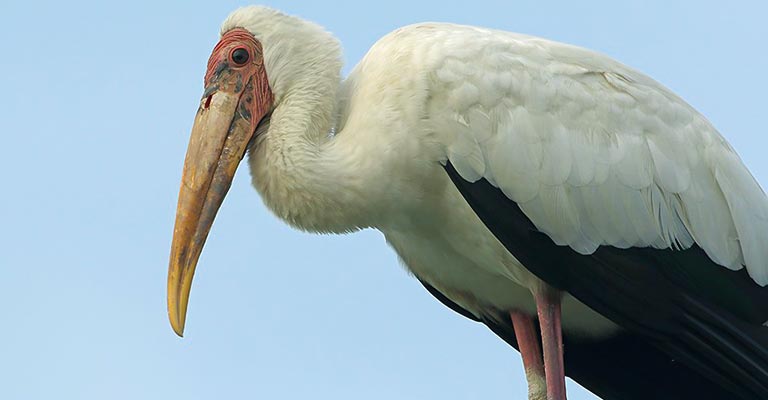
The Milky Stork (Mycteria cinerea) is a distinctive bird species belonging to the stork family, found predominantly in Southeast Asia.
Identifying this elegant bird involves recognizing several key characteristics distinguishing it from other species. Here are some notable features that aid in the identification of the Milky Stork:
Size and Shape
The Milky Stork is a large bird with a height ranging between 85 to 105 centimeters (33 to 41 inches). Its long legs and neck contribute to its characteristic stork-like appearance.
When observed in flight, its broad wingspan of approximately 150 to 165 centimeters (59 to 65 inches) becomes apparent.
Coloration
This stork’s stork is predominantly white. Hence, the “Milky” Stork, “however,” has wings and back features contrasting black flight feathers, particularly noticeable during flight.
The head is adorned with a distinctive black cap extending down to the eyes, which stand out against the bird’s white plumage.
Bill
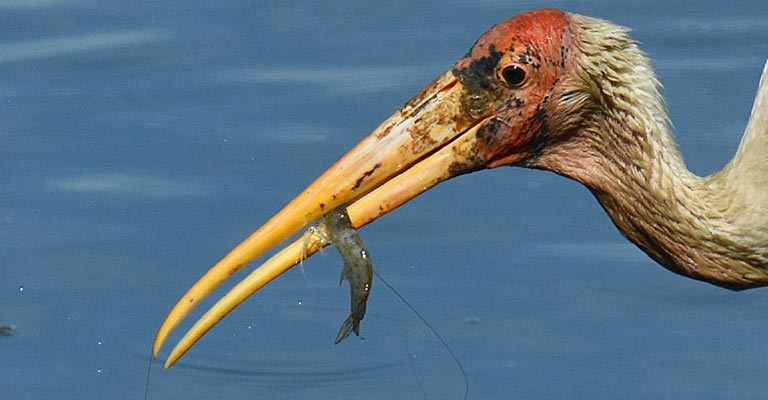
One of the most distinguishing features of the Milky Stork is its long, sturdy bill.
The bill is yellowish-orange and slightly curved at the tip, facilitating the bird’s feeding behavior. Its robust nbird’sis are well-suited for capturing and consuming a variety of aquatic prey.
Legs and Feet
The Milky Stork’s legs are long and slender, coStork’sn a dull pink or pale gray shade.
These legs are perfectly adapted for wading through shallow water for food. Its feet are webbed, aiding in balance and propulsion while navigating wetland habitats.
Voice
While generally silent outside of the breeding season, Milky Storks can emit various vocalizations during courtship and nesting periods.
These calls include a series of hoarse croaks and grunts, which may serve as communication signals between individuals or as territorial displays.
Habitat Info
The Milky Stork primarily inhabits wetland habitats such as mangroves, estuaries, mudflats, and freshwater marshes.
These environments provide ample food sources, including fish, frogs, crustaceans, and small mammals, which constitute the stork’s diet.
Behavior
When foraging, Milky Storks can be observed standing motionless in shallow water, patiently waiting for prey to come within striking distance.
They utilize their sharp bill to probe the substrate or snatch prey from the water’s surface with swift, precise movements.
Conservwater’status
Finally, the conservation status of the Milky Stork is an essential consideration in its identification. Classified as endangered due to habitat loss, pollution, and hunting, conservation efforts are crucial for ensuring the survival of this species.
Conservation measures often involve habitat protection, captive breeding programs, and community outreach initiatives to raise awareness about these majestic birds’ plight.
The Milky Stork can be identified by its large size, contrasting black and white plumage, distinctive bill, habitat preference, and conservation status.
Recognizing these key characteristics is essential for conservationists, birdwatchers, and enthusiasts alike, helping to ensure the continued survival of this iconic species in the wild.
Taxonomy of Milky Stork
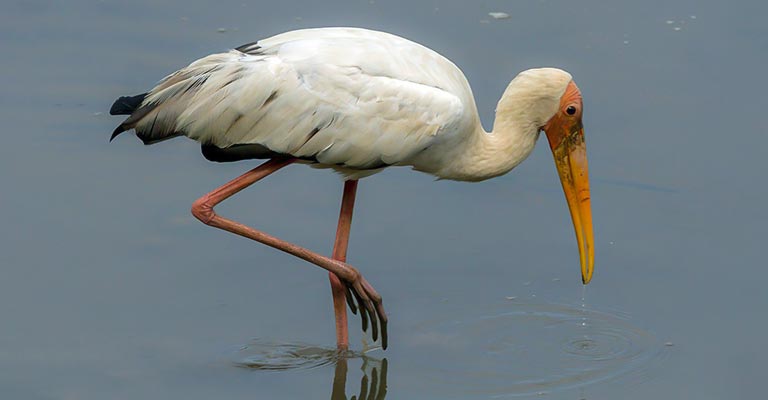
The table below detailing the taxonomy of the Milky Stork will come in very handy:
| Domain | Eukaryota |
| Kingdom | Animalia |
| Phylum | Chordata |
| Class | Aves |
| Clade | Aequornithes |
| Order | Ciconiiformes (Bonaparte, 1854) |
| Family | Ciconiidae |
| Genus | Mycteria |
| Species | M. cinerea |
The Milky Stork (Mycteria cinerea) belongs to the Animalia kingdom, the Chordata phylum, and the Aves class.
It is further classified under the Pelecaniformes order, which includes birds with webbed feet and long bills for hunting aquatic prey.
Within the Pelecaniformes order, the Milky Stork is placed in the family Ciconiidae, commonly known as the stork family. This family encompasses large, wading birds characterized by long legs and necks.
The Milky Stork is assigned to the genus Mycteria, which comprises six species of storks. Its specific epithet, cinerea, denotes its characteristic grayish-white plumage, distinguishing it from other stork species.
Hunting Habit of Milky Stork
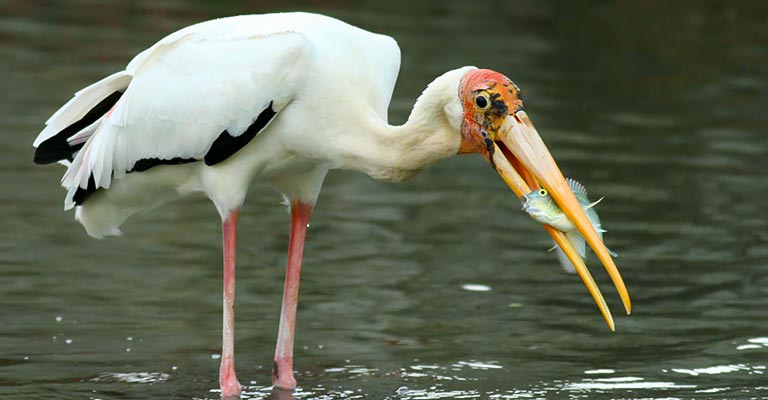
The Milky Stork is a patient and methodical hunter, typically foraging in shallow waters of wetland habitats. With its long legs and webbed feet, it wades through the water, remaining motionless until prey comes within striking distance.
Its sharp, yellowish-orange bill probes the substrate or swiftly snatches prey from the water’s surface. Its diet primarily consists of fish, frogs, crustaceans, and small mammawater’sch, which it captures with precise movements.
During the breeding season, Milky Storks may also hunt cooperatively, using strategic movements to corral prey into more accessible areas.
While they are generally silent outside the breeding season, Milky Storks may emit vocalizations during hunting, including low croaks and grunts.
Their hunting habits reflect their adaptation to wetland environments and specialized feeding techniques.
Milky Stork Life History
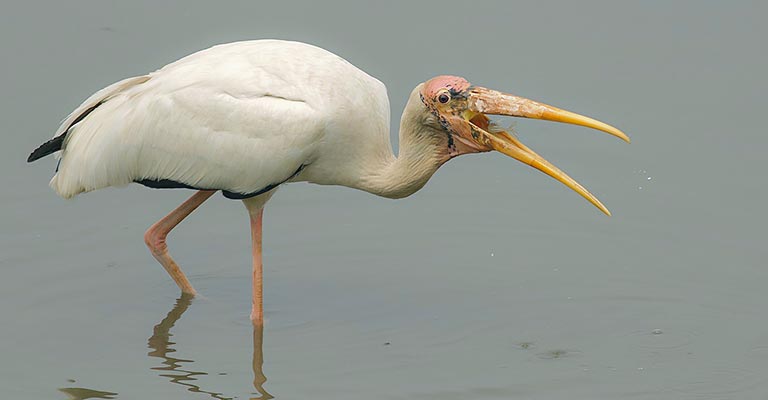
The Milky Stork (Mycteria cinerea) is a majestic bird species belonging to the stork family, characterized by its striking black and white plumage and long, sturdy bill.
Found primarily in Southeast Asia, this species inhabits various wetland habitats, demonstrating specialized hunting techniques to capture its prey.
Understanding the life history of the Milky Stork involves examining its feeding behavior, habitat preferences, breeding habits, susceptibility to diseases, conservation status, and potential treatments.
Food
Milky Storks are opportunistic feeders, preying on various aquatic creatures in their wetland habitats. Their diet consists mainly of fish, frogs, crustaceans, and small mammals.
With their sharp bills and patient hunting habits, they are adept at catching prey both in shallow waters and on the water’s surface.
Habitat
These storks inhabit various wetland environments, including mangroves, estuaries, mudflats, and freshwater waters.
They rely on these habitats for foraging, nesting, and roosting, as they provide abundant food sources and suitable nesting sites.
Range Map
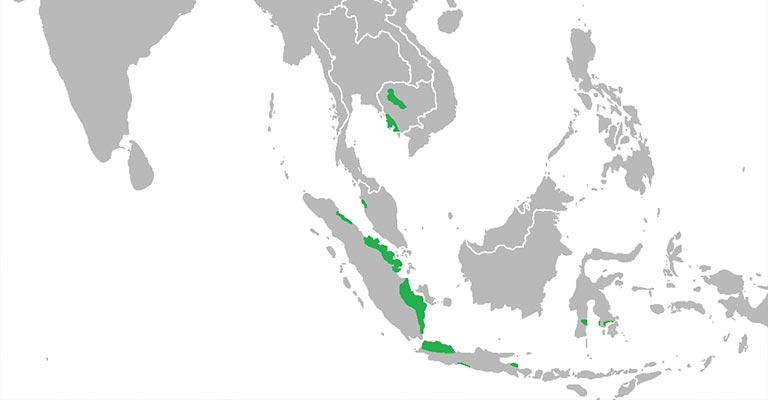
The Milky Stork’s range extends across Southeast Asia, including countries such as Malaysia, Indonesia, Thailand, Vietnam, and Cambodia. Its distribStork’say varies within this range due to habitat availability and human impacts.
Breeding
Breeding season for Milky Storks typically occurs during the dry season when water levels are lower, facilitating more accessible access to food and nesting sites.
They often build large stick nests in trees near water bodies, where they lay a clutch of eggs. Both parents share incubation duties and care for the young chicks until they fledge.
Diseases
Like many bird species, Milky Storks are susceptible to various diseases, including avian influenza, Newcastle disease, and avian botulism.
These diseases can devastate stork populations, especially when they come into contact with domestic poultry or contaminated water sources.
Treatment
Treatment of diseases in Milky Storks often involves veterinary intervention, including vaccination, medication, and supportive care.
Additionally, measures to reduce exposure to contaminated environments and prevent transmission between individuals are crucial for managing disease outbreaks.
Conservation
The Milky Stork faces significant conservation challenges due to habitat loss, pollution, and human disturbance.
Efforts to conserve this species include habitat protection, restoration initiatives, captive breeding programs, and community education and outreach.
Collaborative conservation efforts involving government agencies, non-profit organizations, and local communities are essential for ensuring the long-term survival of the Milky Stork and its wetland habitats.
The life history of the Milky Stork encompasses various aspects of its ecology, behavior, and conservation. Understanding these factors is crucial for implementing effective conservation strategies to safeguard this iconic bird species and the ecosystems upon which it depends.
Nesting Habit of Milky Stork
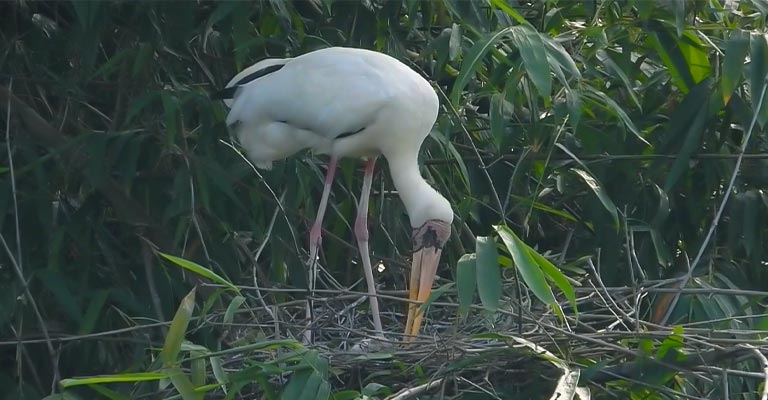
Check out the following table detailing the nesting habits of the Milky Stork:
| Nesting Detail | Description |
| Clutch Size | Typically 2 to 4 eggs per clutch |
| Number of Broods | It lasts around 28 to 32 days |
| Egg Length | Approximately 8 to 10 centimeters (3 to 4 inches) |
| Egg Width | Approximately 5 to 6 centimeters (2 to 2.5 inches) |
| Incubation Period | Smooth and glossy, with a pale bluish-green color; may have slight variations in color and markings. |
| Nestling Period | Chicks fledge after approximately 60 to 70 days |
| Egg Description | Typically located in trees or tall vegetation near wetlands, providing both protection and easy access to food sources. |
| Nest Construction | Constructed from sticks and twigs, forming large platform nests placed high in trees or other elevated structures near water bodies |
| Nest Location | Both parents share incubation duties and care for the nestlings, regurgitating food to feed them until they are old enough to feed themselves. |
| Parental Care | Smooth and glossy, with a pale bluish-green color, may have slight variations in color and markings. |
This table provides a comprehensive overview of the nesting behavior and characteristics of the Milky Stork, including details such as clutch size, egg dimensions, incubation and nestling periods, egg description, nest construction, and parental care.
Milky Storks construct large platform nests made of sticks and twigs, typically positioned high in trees near water bodies. Each clutch normally consists of 2 to 4 pale bluish-green eggs, which are smooth and glossy.
Both parents are responsible for incubating the eggs, which takes approximately 28 to 32 days.
After hatching, the nestlings are cared for by both parents, who regurgitate food until they are ready to feed themselves.
Nestlings fledge after about 60 to 70 days, completing the nesting cycle of these majestic birds in their preferred wetland habitats.
5 Behavioral Habits of Milky Stork
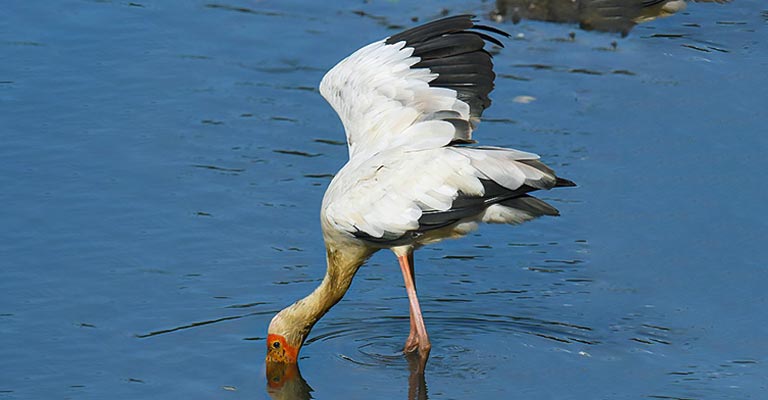
The behavioral habits of the Milky Stork (Mycteria cinerea) provide fascinating insights into these majestic birds’ daily lives. Here are five noteworthy behavioral traits exhibited by Milky Storks:
Foraging Strategy
Milky Storks employ a patient and methodical foraging strategy, often standing motionless in shallow waters while waiting for prey to come within striking distance.
With their sharp bills, they skillfully capture fish, frogs, crustaceans, and small mammals, demonstrating precision and efficiency in their hunting techniques.
Social Behavior
While typically solitary outside of the breeding season, Milky Storks may gather in small groups, particularly during feeding or roosting activities.
However, they maintain territorial boundaries and may display aggressive behaviors towards intruders, especially during the breeding season.
Courtship Displays
During the breeding season, Milky Storks engage in elaborate courtship displays to attract mates.
These displays may involve aerial acrobatics, bill clattering, mutual preening, strengthening pair bonds, and establishing mating compatibility.
Parental Care
Both parents share the responsibilities of incubating the eggs, feeding the nestlings, and defending the nest against potential threats.
Their cooperative efforts ensure the survival and well-being of the offspring throughout the nesting period.
Vocalizations
While generally silent outside the breeding season, Milky Storks may emit vocalizations, including low croaks and grunts, particularly during courtship, territorial disputes, or alarm calls.
These vocalizations are crucial in communication and maintaining social cohesion within the stork population.
These behavioral habits contribute to the adaptability and survival of Milky Storks in their wetland habitats, showcasing their remarkable abilities and complex social dynamics.
Wrapping Up
The Milky Stork exemplifies adaptability and resilience in its wetland habitats, with its distinctive behaviors and nesting habits underscoring its significance in the ecosystem.
From patient foraging strategies to cooperative parental care, these majestic birds navigate the challenges of their environment with finesse.
However, amidst habitat loss and conservation concerns, efforts to protect and preserve their habitats are crucial for ensuring the continued survival of the Milky Stork and its vital role in maintaining the ecological balance of Southeast Asia’s wetlands. Thank you so much.